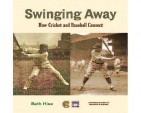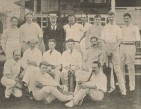Home Ground
Alex Fensome |
My cricket team plays on a sloping pitch on one side of a gentle river valley in the Blackdown Hills which border Somerset and Devon. We have no pavilion, and use an unfurnished back room in the village hall as a changing area. There are showers, and we use the hall’s kitchen to prepare the teas. At the top of the slope there are two sheds, a secure one in which we keep the mower and rollers and a ramshackle old thing crammed with club kit, the scorer’s table and the scoreboard numbers in a green tray. We have some benches there where the players can sit, and a recently-purchased wheeled net that can be dragged onto a roughly cut strip in the outfield. We also have a ragged old mat net that has been rotting as long as I’ve been there but can still be used in a pinch, as long as you don’t hit your arm on the tree that overhangs the bowling crease. I once batted in there without my gloves before a game, and got hit on the wrist by a fast beamer. Not thinking much of it, I bowled eight overs and could barely move my arm afterwards.
At one end of the field there is the village hall, its car park and the village tennis court. At the other is a field with cows, sometimes calves. Our sightscreens used to run on skids but were replaced with wheeled ones a year or so ago. They have to have brakes to stop them rolling down the hill and crashing through the chain-link fence into the lane.
At the bottom corner of the ground is a farm with a big corrugated iron barn and an orchard, into which balls often disappear. There’s a farm track between the ground and the bushy farm hedge, which joins the lane that runs up the other side of the valley to the A303. The village pub is accessed through a gate at the top end of the car park- go through there and you are straight into the pub’s own car park. Some players choose to arrive early and have a pint or two before the match.
Trees droop over the topside boundary; three trunks inside the playing area. In late summer their leaves start to cover the ground, a frustration for batsmen already struggling against the gradient. From underneath one of the trees you can stand and look out over the upper reaches of the valley, and it is really quite attractive. The ground has been described as “quaint”, “quirky” and “rustic”, not altogether without reason.
I have spent a good part of the last five summers of my life on this ground. I’ve seen lots of good cricket and not a little bad, done well personally at times and struggled at others, been reduced to impotent rage at failures and ecstatic joy at success. I’ve played some good shots, bowled some good deliveries, dropped lots of dollies and once headed a ball for six trying to take a catch in the outfield. The team’s success has varied considerably. Once we bowled out the league’s top side for 47, a delirious, utterly implausible day when everything went right. On another, the first team conceded over 300 and lost by just four runs off the last ball. Most of the time I was playing for the second team, and am the captain of it this season, though our record so far leaves some wondering if I will be statistically the worst skipper in history. I hope not. God knows I am trying, and hopefully we can turn it around. The best part is that you are playing with your mates. I never stop enjoying it.
Visiting teams don’t really like playing here, unless they are on tour, in which case they are too drunk to care. Bowlers always struggle with the slope at first, a fact we try to exploit by opening with left-handers. Unfortunately, if they do get used to it, the slope offers ample opportunities for cut and spin- more often than not it swings as well. The wicket is slow and low, though Marcus Trescothick, playing in a benefit match last season, said he was not playing on a typical village wicket, a nice complement for the dedicated pair of gents who tend it. The boundaries are short, and on hot days big scores are the norm. It is very difficult to field on the bottom side of the slope because the ball rushes down on you, and it can be difficult to judge trajectories- hence how I managed to head that ball for six, an incident I am never allowed to forget.
When batting balance is an issue- I adopted a faintly ludicrous crab-like open stance for years to cope with it. It is no coincidence that the best pitch for batting is the one with the gentlest gradient. You get more value for shots down the hill, which can be helpful if your best shot is a leg-side hoick. Then again, it isn’t that difficult to adjust. Visiting players don’t seem to have much problem facing my bowling anyway. Nor did the Devon all-rounder who hit six sixes in an over off the ex first-team captain a few years before I joined the club.
This is the reality of English cricket for many players; village grounds with odd little rules and idiosyncratic settings where teams struggle to stay in the F Division of the county league or beat a bunch of cider-drunk Surrey lads who happen to have a South African state player who opens the bowling and the batting. But it is just the best thing in the world. Those minor epics- fifty-run last wicket stands between two young brothers, a juggled catch or a diving stop down on the boundary; they are more fun, and mean more to club cricketers at our level than they ever could to professionals, or even those playing in higher divisions where the captain shouts if you do something wrong. This is what cricket always has been for the vast herd of people out there who will never make it to the “top”.
I am moving to New Zealand in the winter, and I may not return for some time. I’m pretty sure I won’t find anything like my old club out there. When I do return, the chances are the club will have finally moved to the other side of the village, to a pitch next to the football ground. They’ll have built a clubhouse and the wicket won’t feel like standing on the side of a mountain. You won’t have to pick your way through a herd of cows to fetch the ball, and neither will both teams be crammed into one small changing room to have tea. It will be far better facility. But will it be a better place to play cricket?





Leave a comment